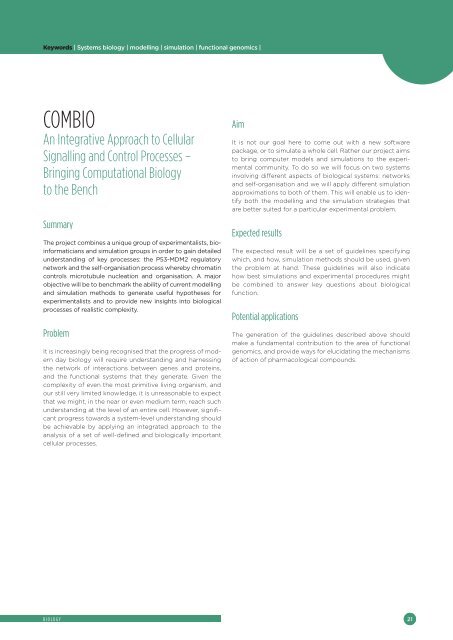Create successful ePaper yourself
Turn your PDF publications into a flip-book with our unique Google optimized e-Paper software.
Keywords | Systems biology | modelling | simulation | functional genomics |<br />
COMBIO<br />
An Integrative Approach to Cellular<br />
Signalling and Control Processes –<br />
Bringing Computational Biology<br />
to the Bench<br />
Summary<br />
The project combines a unique group of experimentalists, bioinformaticians<br />
and simulation groups in order to gain detailed<br />
understanding of key processes: the P53-MDM2 regulatory<br />
network and the self-organisation process whereby chromatin<br />
controls microtubule nucleation and organisation. A major<br />
objective will be to benchmark the ability of current modelling<br />
and simulation methods to generate useful hypotheses for<br />
experimentalists and to provide new insights into biological<br />
processes of realistic complexity.<br />
Problem<br />
It is increasingly being recognised that the progress of modern<br />
day biology will require understanding and harnessing<br />
the network of interactions between genes and proteins,<br />
and the functional systems that they generate. Given the<br />
complexity of even the most primitive living organism, and<br />
our still very limited knowledge, it is unreasonable to expect<br />
that we might, in the near or even medium term, reach such<br />
understanding at the level of an entire cell. However, signifi -<br />
cant progress towards a system-level understanding should<br />
be achievable by applying an integrated approach to the<br />
analysis of a set of well-defi ned and biologically important<br />
cellular processes.<br />
BIOLOGY 21<br />
Aim<br />
It is not our goal here to come out with a new software<br />
package, or to simulate a whole cell. Rather our project aims<br />
to bring computer models and simulations to the experimental<br />
community. To do so we will focus on two systems<br />
involving diff erent aspects of biological systems: networks<br />
and self-organisation and we will apply diff erent simulation<br />
approximations to both of them. This will enable us to identify<br />
both the modelling and the simulation strategies that<br />
are better suited for a particular experimental problem.<br />
Expected results<br />
The expected result will be a set of guidelines specifying<br />
which, and how, simulation methods should be used, given<br />
the problem at hand. These guidelines will also indicate<br />
how best simulations and experimental procedures might<br />
be combined to answer key questions about biological<br />
function.<br />
Potential applications<br />
The generation of the guidelines described above should<br />
make a fundamental contribution to the area of functional<br />
genomics, and provide ways for elucidating the mechanisms<br />
of action of pharmacological compounds.
















